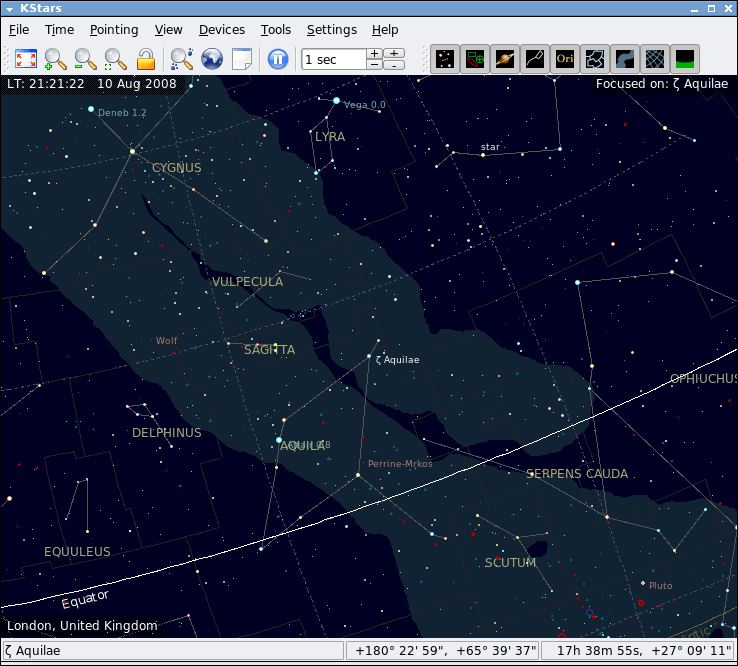KStars is an open source desktop planetarium for KDE.
It depicts an accurate simulation of the night sky, including stars, constellations, star clusters, nebulae, galaxies, all 8 planets, the Sun, the Moon, comets and asteroids. You can see the sky as it appears from any location on Earth, on any date.
The user interface is highly intuitive and flexible. The display can be panned and zoomed with the mouse, and you can easily identify objects and track their motion across the sky. KStars includes many powerful features, yet the interface is clean and simple and fun to use.
Features include:
- 130,000 stars to 9th magnitude.
- 13,000 deep-sky objects (Messier, NGC, and IC catalogs).
- Milky Way.
- 88 constellations.
- Guide lines such as the celestial equator, the horizon and the ecliptic.
- Control telescopes and cameras, using the elegant and powerful INDI protocol:
- Supports several popular telescopes including Meade’s LX200 family and Celestron GPS.
- CCD cameras, webcams, and computerized focusers.
- Interface to a number of tools with which you can learn more about astronomy and the night sky:
- Astrocalculator tool provides direct access to many of the algorithms the program uses behind the scenes, including coordinate converters and time calculators.
- AAVSO Lightcurve Generator tool will download a lightcurve for any of the 6000+ variable stars monitored by the American Association of Variable Star Observers (AAVSO).
- Plan an observing session using our Altitude vs. Time tool, which will plot curves representing the Altitude as a function of time for any group of objects.
- What’s Up Tonight? tool that summarizes the objects that.
you will be able to see from your location on any given night. - Solar System Viewer, which shows the current configuration of the major planets in our solar system.
- Jupiter Moons Tool which shows the positions of Jupiter’s four largest moons as a function of time.
- Context-sensitive popup menu.
- Provides an observation planner, a sky calendar tool, and an FOV editor to calculate field of view of equipment and display them
- Supports adjustable simulation speeds in order to view phenomena that happen over long timescales.
- KStars Astrocalculator to predict conjunctions.
Website: kstars.kde.org
Support: KStars Handbook
Developer: Jason Harris, Heiko Evermann, Thomas Kabelmann, Pablo de Vicente, Jasem Mutlaq, Mark Hollomon
License: GNU General Public License v2.0

KStars is written in C++. Learn C++ with our recommended free books and free tutorials.
Return to Scientific | Return to Astronomy
| Popular series | |
|---|---|
| The largest compilation of the best free and open source software in the universe. Each article is supplied with a legendary ratings chart helping you to make informed decisions. | |
| Hundreds of in-depth reviews offering our unbiased and expert opinion on software. We offer helpful and impartial information. | |
| The Big List of Active Linux Distros is a large compilation of actively developed Linux distributions. | |
| Replace proprietary software with open source alternatives: Google, Microsoft, Apple, Adobe, IBM, Autodesk, Oracle, Atlassian, Corel, Cisco, Intuit, and SAS. | |
| Awesome Free Linux Games Tools showcases a series of tools that making gaming on Linux a more pleasurable experience. This is a new series. | |
| Machine Learning explores practical applications of machine learning and deep learning from a Linux perspective. We've written reviews of more than 40 self-hosted apps. All are free and open source. | |
| New to Linux? Read our Linux for Starters series. We start right at the basics and teach you everything you need to know to get started with Linux. | |
| Alternatives to popular CLI tools showcases essential tools that are modern replacements for core Linux utilities. | |
| Essential Linux system tools focuses on small, indispensable utilities, useful for system administrators as well as regular users. | |
| Linux utilities to maximise your productivity. Small, indispensable tools, useful for anyone running a Linux machine. | |
| Surveys popular streaming services from a Linux perspective: Amazon Music Unlimited, Myuzi, Spotify, Deezer, Tidal. | |
| Saving Money with Linux looks at how you can reduce your energy bills running Linux. | |
| Home computers became commonplace in the 1980s. Emulate home computers including the Commodore 64, Amiga, Atari ST, ZX81, Amstrad CPC, and ZX Spectrum. | |
| Now and Then examines how promising open source software fared over the years. It can be a bumpy ride. | |
| Linux at Home looks at a range of home activities where Linux can play its part, making the most of our time at home, keeping active and engaged. | |
| Linux Candy reveals the lighter side of Linux. Have some fun and escape from the daily drudgery. | |
| Getting Started with Docker helps you master Docker, a set of platform as a service products that delivers software in packages called containers. | |
| Best Free Android Apps. We showcase free Android apps that are definitely worth downloading. There's a strict eligibility criteria for inclusion in this series. | |
| These best free books accelerate your learning of every programming language. Learn a new language today! | |
| These free tutorials offer the perfect tonic to our free programming books series. | |
| Linux Around The World showcases usergroups that are relevant to Linux enthusiasts. Great ways to meet up with fellow enthusiasts. | |
| Stars and Stripes is an occasional series looking at the impact of Linux in the USA. | |
